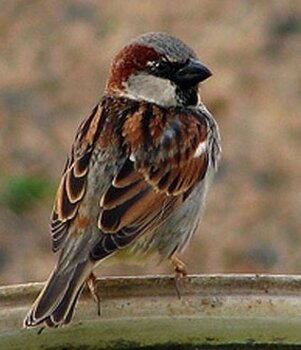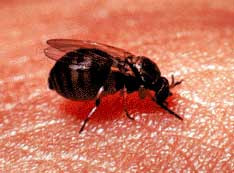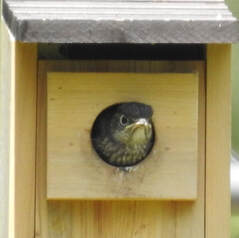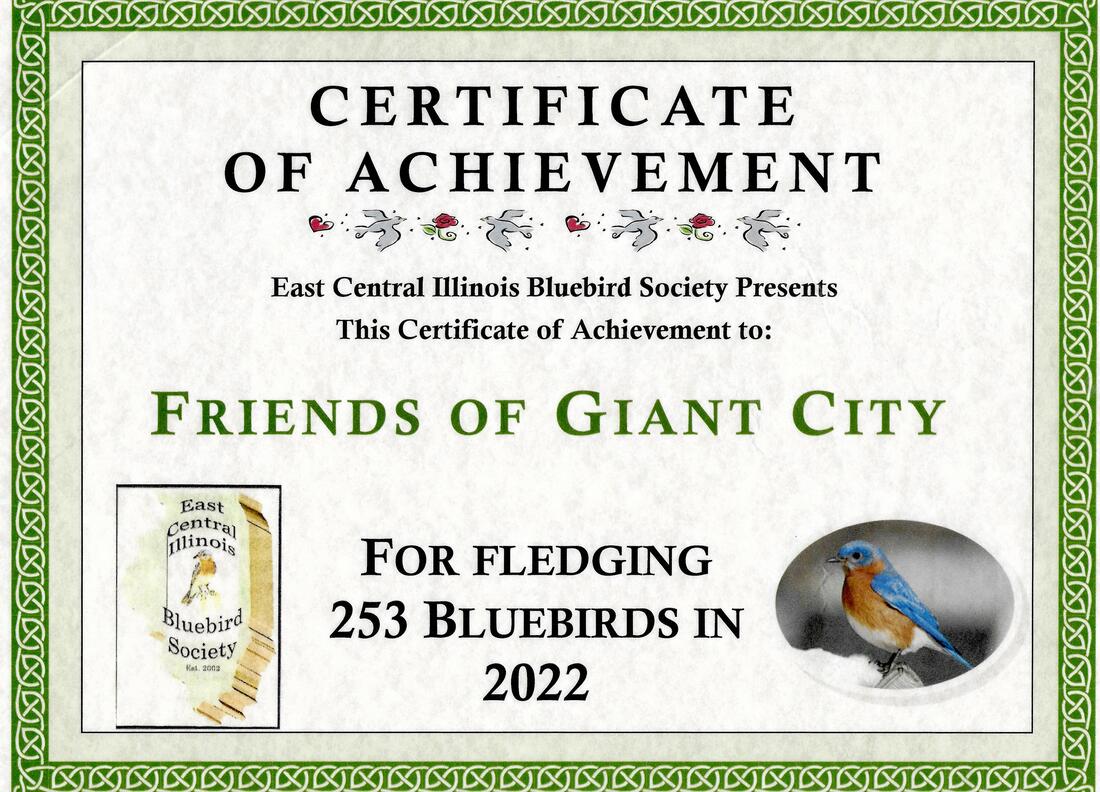THE BLUEBIRD CARRIES THE SKY ON HIS BACK
---Henry David Thoreau---
From 1920-1990, the Bluebird population declined by an estimated 90% because of a lack of habitat and competition from other species. Bluebirds are secondary cavity nesting birds and need to find a hole in a tree or fence post that a woodpecker or flicker has made. Trees with these holes have been inadvertently destroyed by human activities. Dead trees, which contain tree holes have been harvested for firewood or taken down because of appearance. Without nest boxes, the Bluebird population would decline even further. Bluebirds also have to compete for nesting areas with non-native or other introduced bird species such as House Sparrows and Starlings. Bluebirds can live about 2-3 years. It is estimated that about fifty percent of fledglings do not make it though the first few months of life.
Giant City State Park has 60 Bluebird nest boxes situated throughout the park. In order to better understand the Bluebird activity in the nest boxes, they were monitored for the first time in 2006. The Friends of Giant City, a non-profit organization, had volunteers who checked their assigned nest boxes every seven to ten days during the nesting season (March-August). An information sheet on each box was filled-out and contained the date checked, if there was a nest and the species, number of eggs, number of fledglings, and any comments. At the end of the nesting season, all the information was compiled and sent to the East Central Illinois Bluebird Society.
In compiling all the data over 10-Years [2006-2015], there were a total of 2,718 Bluebirds successfully fledged at Giant City State Park.
Bluebird Facts:
Sources of information about Bluebirds:
The Bluebird Book: The Complete Guide to Attracting Bluebirds, by Donald & Lillian Stokes (c.1991)
The Bluebird Monitor’s Guide, by C. Berger, K. Kridler, & J. Griggs
Eastern Central Illinois Bluebird Society, 1234 Tucker Beach Rd., Paris, IL 61944, 217-463-7175
North American Bluebird Society, Dept. G., P.O. BOX 74, Darlington, WI 53530-0074, or,
website: http://www.nabluebirdsociety.org
IDNR Brochure GEMS of BLUE: https://www.dnr.illinois.gov/education/Documents/BLUEBIRD.pdf
A website resource that is all about Bluebirds: www.sialis.org
---Henry David Thoreau---
From 1920-1990, the Bluebird population declined by an estimated 90% because of a lack of habitat and competition from other species. Bluebirds are secondary cavity nesting birds and need to find a hole in a tree or fence post that a woodpecker or flicker has made. Trees with these holes have been inadvertently destroyed by human activities. Dead trees, which contain tree holes have been harvested for firewood or taken down because of appearance. Without nest boxes, the Bluebird population would decline even further. Bluebirds also have to compete for nesting areas with non-native or other introduced bird species such as House Sparrows and Starlings. Bluebirds can live about 2-3 years. It is estimated that about fifty percent of fledglings do not make it though the first few months of life.
Giant City State Park has 60 Bluebird nest boxes situated throughout the park. In order to better understand the Bluebird activity in the nest boxes, they were monitored for the first time in 2006. The Friends of Giant City, a non-profit organization, had volunteers who checked their assigned nest boxes every seven to ten days during the nesting season (March-August). An information sheet on each box was filled-out and contained the date checked, if there was a nest and the species, number of eggs, number of fledglings, and any comments. At the end of the nesting season, all the information was compiled and sent to the East Central Illinois Bluebird Society.
In compiling all the data over 10-Years [2006-2015], there were a total of 2,718 Bluebirds successfully fledged at Giant City State Park.
Bluebird Facts:
- Eastern Bluebird – breeds throughout the eastern half of the United States and southern Canada
- Mountain Bluebird – breeds in all the western states and western Canadian provinces
- March through August is nest building season
- Nests can be built in as little as 2 days, but normally it takes 4-5 days
- Nests are made from grasses, pine needles, fine week stalks and fine rootlets.
- Nests are in the shape of a small cup about 2 inches wide and 2 inches deep
- Females lay 1 egg each day until a clutch of 3 to 6 eggs are laid
- Eggs are about the size of a grape and are sky blue in color. Sometimes the eggs are white.
- 65% of all eggs hatch
- 12-14 days on average for incubation
- 16-21 days on average before fledgling
- Fledglings need about 2 weeks of “instruction” to learn how to feed themselves
- Fledglings may help in the feeding of subsequent broods
- Insects are about 90% of Bluebirds diet in summer (grasshoppers, crickets, spiders, ground beetles caterpillars, flies, cutworms, maggots, corn borers, alfalfa beetles, millipedes, centipedes, sow bugs)
- Fruits and berries are also a part of their diet
Sources of information about Bluebirds:
The Bluebird Book: The Complete Guide to Attracting Bluebirds, by Donald & Lillian Stokes (c.1991)
The Bluebird Monitor’s Guide, by C. Berger, K. Kridler, & J. Griggs
Eastern Central Illinois Bluebird Society, 1234 Tucker Beach Rd., Paris, IL 61944, 217-463-7175
North American Bluebird Society, Dept. G., P.O. BOX 74, Darlington, WI 53530-0074, or,
website: http://www.nabluebirdsociety.org
IDNR Brochure GEMS of BLUE: https://www.dnr.illinois.gov/education/Documents/BLUEBIRD.pdf
A website resource that is all about Bluebirds: www.sialis.org
House Sparrows [formerly named English Sparrows]

HOUSE /English SPARROWS - Non-native bird species
[Photo of MALE House/English Sparrow]
History: First introduced from England beginning in the 1850s, on the mistaken premise they would help reduce insect pests. However, it was soon realized it was a mistake. Their population increased at an explosive and alarming rate, and the birds caused extensive damage to crops and fruit trees. They also took over the nesting sites of native cavity-nesting birds, such as Bluebirds.
Life & Habits: They are extremely aggressive. They will harass, attack, and kill adult native birds when competing for nest sites, and destroy their eggs and young. House Sparrows quickly build a bulky nest of coarse grasses with seed heads, weeds, trash, and feathers. The female lays three to eight white/greenish eggs heavily speckled with brown and incubates fro 11-13 days. The young house sparrows fledge after 14-17 days and can have 2-4 broods per year.
Control on a Bluebird Trail: They are not protected under federal law. Nests and eggs should be destroyed. Be sure that the nest and eggs are that of a House Sparrow
before removing the nests or eggs.
[Source: North American Bluebird Society Factsheet - House Sparrow Control, revised May 2012]
[Photo of MALE House/English Sparrow]
History: First introduced from England beginning in the 1850s, on the mistaken premise they would help reduce insect pests. However, it was soon realized it was a mistake. Their population increased at an explosive and alarming rate, and the birds caused extensive damage to crops and fruit trees. They also took over the nesting sites of native cavity-nesting birds, such as Bluebirds.
Life & Habits: They are extremely aggressive. They will harass, attack, and kill adult native birds when competing for nest sites, and destroy their eggs and young. House Sparrows quickly build a bulky nest of coarse grasses with seed heads, weeds, trash, and feathers. The female lays three to eight white/greenish eggs heavily speckled with brown and incubates fro 11-13 days. The young house sparrows fledge after 14-17 days and can have 2-4 broods per year.
Control on a Bluebird Trail: They are not protected under federal law. Nests and eggs should be destroyed. Be sure that the nest and eggs are that of a House Sparrow
before removing the nests or eggs.
[Source: North American Bluebird Society Factsheet - House Sparrow Control, revised May 2012]
GIANT CITY STATE PARK
BLUEBIRD NEST BOX MONITORING DATA 2023
Trail Name No. of No. of No. of Other Species
& No. of Boxes Eggs Young Fledglings Nests
Mammal #1 – 12 45 29 29 Chickadee-7eggs/5young
Squirrel (?)
Mammal #2 – 7 51 45 45
Bird – 10 78 70 67
Herp – 11 87 84 84 Chickadee-0eggs
Tree – 12 111 98 94
Flower – 8 80 53 53 Tree Swallow 5ggs/5young; Squirrel (?)
_______________________________________________________________________
TOTAL: 60 452 379 372
Bluebird egg to fledgling rate was 82% for the 2023 nesting season. Sometimes eggs are infertile. Predation of the nests by snakes and raccoons is always a problem. Unfortunately, in 2023, there was Human Predation of 5 eggs. It is illegal to destroy or disturb nests or eggs of any wild bird.
In 2023 and 2022, with high temperatures and 3-digit heat index over the summer, the concern was how the temperature inside the nest box might affect the bluebird chicks. In 2021, the concern was quite different because of the freezing temperatures and ice storms that lasted for 7 days in February. That killed a lot of the adult birds before the nesting season started late March or early April in Southern Illinois.
The 2023 bluebird nesting data shows the bluebirds are recovering from the losses of 2021.
Other Species Nests Comparison with 2022 Data
In 2023, there was a Tree Swallow nest with 5eggs/5young and one Chickadee nest with 7ggs/5young. One box had a squirrel nest. In 2022, there were Chickadee nests for a total of 28eggs/26 young. Two boxes had squirrel nests.
(Data compiled by Amber Hewette, September 2023)
BLUEBIRD NEST BOX MONITORING DATA 2023
Trail Name No. of No. of No. of Other Species
& No. of Boxes Eggs Young Fledglings Nests
Mammal #1 – 12 45 29 29 Chickadee-7eggs/5young
Squirrel (?)
Mammal #2 – 7 51 45 45
Bird – 10 78 70 67
Herp – 11 87 84 84 Chickadee-0eggs
Tree – 12 111 98 94
Flower – 8 80 53 53 Tree Swallow 5ggs/5young; Squirrel (?)
_______________________________________________________________________
TOTAL: 60 452 379 372
Bluebird egg to fledgling rate was 82% for the 2023 nesting season. Sometimes eggs are infertile. Predation of the nests by snakes and raccoons is always a problem. Unfortunately, in 2023, there was Human Predation of 5 eggs. It is illegal to destroy or disturb nests or eggs of any wild bird.
In 2023 and 2022, with high temperatures and 3-digit heat index over the summer, the concern was how the temperature inside the nest box might affect the bluebird chicks. In 2021, the concern was quite different because of the freezing temperatures and ice storms that lasted for 7 days in February. That killed a lot of the adult birds before the nesting season started late March or early April in Southern Illinois.
The 2023 bluebird nesting data shows the bluebirds are recovering from the losses of 2021.
Other Species Nests Comparison with 2022 Data
In 2023, there was a Tree Swallow nest with 5eggs/5young and one Chickadee nest with 7ggs/5young. One box had a squirrel nest. In 2022, there were Chickadee nests for a total of 28eggs/26 young. Two boxes had squirrel nests.
(Data compiled by Amber Hewette, September 2023)

BLUEBIRDS & BLACK FLIES [aka Buffalo Gnats]
Black flies are attracted to birds [and humans] largely through the carbon dioxide leaving the nest box as the nestlings exhale. The key to avoid attracting them is by masking the exhaled carbon dioxide.
Some recommended natural repellents include Vanilla extract [not imitation vanilla] or Lavender to cover the scent. It should be sprayed around the entrance hole and vents to the nest box. Also, use cotton balls sprayed with the vanilla or lavender scent and tack or staple them to the inside next to the entrance hole. Spray the cotton ball(s) every few days or at least once a week when you check your nest box.
It is suggested to start spraying the entrance hole & vents after the last egg is laid in the nest. The reason being the female bluebird will be incubating the eggs off and on for 10 or 20 minutes at a time. The carbon dioxide she exhales could attract the black flies to her. Also, it is less disturbing to the female to put up the "saturated" cotton ball(s) before the eggs are hatched. [Material excerpted from article in Bluebird News by Mary Roen and other sources.]
BLACK FLY BASICS
Black flies [aka buffalo gnats or turkey gnats] are small flying insects that feed off the blood of humans and other animals. Though tiny--they reach a maximum length of 1/8" when fully-grown--they are a formidable foe.
Black fly season typically starts in the middle of May and runs through late June or early July. They're often gone by mid-July but a cold, rainy start to the summer (like 2017) can extend the season into August.
Black flies don't breed in still ponds or bird baths like mosquitoes. These insects breed in flowing water, like streams and rivers. Black flies are common in humid, wooded regions in summer months. Black flies are known to travel up to 10 miles from their breeding sites in search of a blood meal. Only female black flies do the biting. They require a nutrient-rich meal of blood to lay their eggs. Male black flies do not bite.
Black flies are attracted to birds [and humans] largely through the carbon dioxide leaving the nest box as the nestlings exhale. The key to avoid attracting them is by masking the exhaled carbon dioxide.
Some recommended natural repellents include Vanilla extract [not imitation vanilla] or Lavender to cover the scent. It should be sprayed around the entrance hole and vents to the nest box. Also, use cotton balls sprayed with the vanilla or lavender scent and tack or staple them to the inside next to the entrance hole. Spray the cotton ball(s) every few days or at least once a week when you check your nest box.
It is suggested to start spraying the entrance hole & vents after the last egg is laid in the nest. The reason being the female bluebird will be incubating the eggs off and on for 10 or 20 minutes at a time. The carbon dioxide she exhales could attract the black flies to her. Also, it is less disturbing to the female to put up the "saturated" cotton ball(s) before the eggs are hatched. [Material excerpted from article in Bluebird News by Mary Roen and other sources.]
BLACK FLY BASICS
Black flies [aka buffalo gnats or turkey gnats] are small flying insects that feed off the blood of humans and other animals. Though tiny--they reach a maximum length of 1/8" when fully-grown--they are a formidable foe.
Black fly season typically starts in the middle of May and runs through late June or early July. They're often gone by mid-July but a cold, rainy start to the summer (like 2017) can extend the season into August.
Black flies don't breed in still ponds or bird baths like mosquitoes. These insects breed in flowing water, like streams and rivers. Black flies are common in humid, wooded regions in summer months. Black flies are known to travel up to 10 miles from their breeding sites in search of a blood meal. Only female black flies do the biting. They require a nutrient-rich meal of blood to lay their eggs. Male black flies do not bite.


